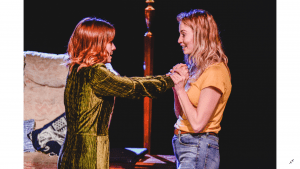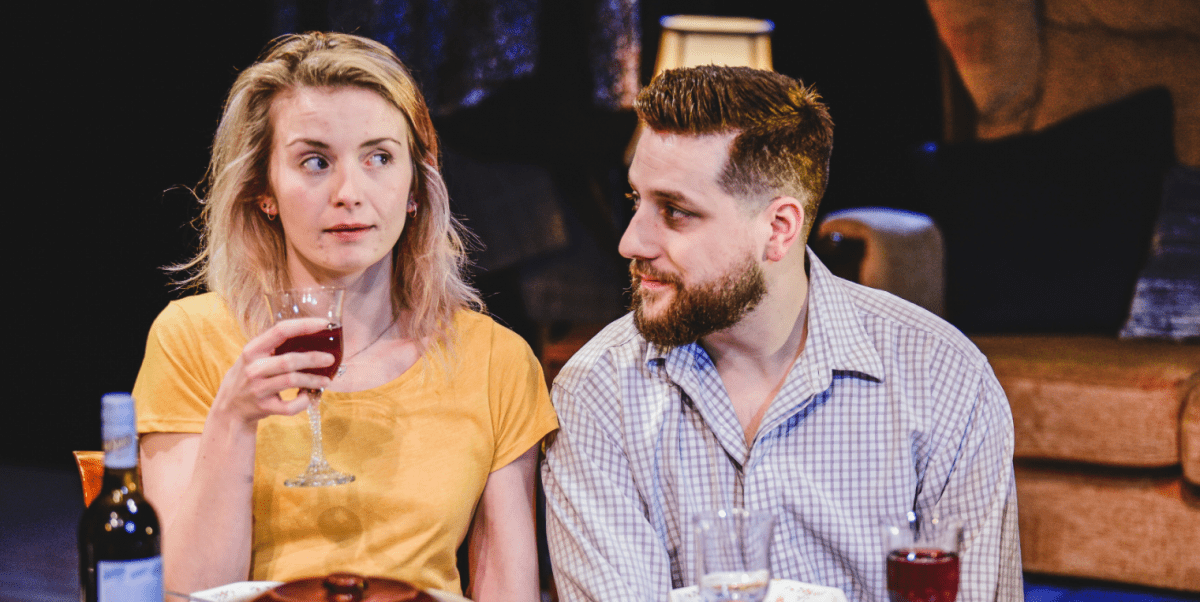A strong cast, a sleek production: on paper, there is a lot to like about BLUE. Rhys Warrington’s first play, the press release tells us, harkens back to the ‘big, classic American texts’. The story itself functions like a gender-swapped version of Tennessee Williams’s The Glass Menagerie: instead of a son supporting his mother and mentally fragile sister, here the daughter of the family, Elin (Sophie Melville), has gone on to London after graduation, leaving her painfully shy brother Huw (Wydion Rhys) and mother Lisa (Nia Robert) behind in the Welsh town of Carmarthen. Reappropriating classic repertoire texts by setting them in a local context has recently led to highly successful renditions, such as Cardiff’s Sherman Theatre’s recent The Cherry Orchard (2017). Here, however, multiple issues get in the way of the production.
![]()
 The first problem is the plot itself. At the beginning of the fateful evening in which the play takes place, Elin has just temporarily returned to see her family. She comes home with her former teacher, the dashing Mr Stevenson (Jordan Barnade). When Elin’s mother interrupts their make-out session, Mr Stevenson (or Thomas, as we come to know him), conceals the real reason for his presence by pretending that Elin invited him for dinner. When the couple goes away, it becomes apparent that Lisa is under the impression that her daughter is trying to set her younger brother up with Thomas. In a discussion with Huw in which she keeps interrupting him, Lisa then expresses her hope to couple her son up with a man who will take care of him when she cannot. The whole situation feels strangely anachronistic and simply hard to believe. As the plot progresses, we come to understand that Huw’s shyness is only part of the puzzle, and we learn more about the reasons for Elin’s departure. There is a bit of social criticism too, as the family’s predicament is made worse by an under-funded health system. It would be wrong to expect BLUE to turn into a piece of dry political comment, of course, but here the problem is only vaguely touched upon.
The first problem is the plot itself. At the beginning of the fateful evening in which the play takes place, Elin has just temporarily returned to see her family. She comes home with her former teacher, the dashing Mr Stevenson (Jordan Barnade). When Elin’s mother interrupts their make-out session, Mr Stevenson (or Thomas, as we come to know him), conceals the real reason for his presence by pretending that Elin invited him for dinner. When the couple goes away, it becomes apparent that Lisa is under the impression that her daughter is trying to set her younger brother up with Thomas. In a discussion with Huw in which she keeps interrupting him, Lisa then expresses her hope to couple her son up with a man who will take care of him when she cannot. The whole situation feels strangely anachronistic and simply hard to believe. As the plot progresses, we come to understand that Huw’s shyness is only part of the puzzle, and we learn more about the reasons for Elin’s departure. There is a bit of social criticism too, as the family’s predicament is made worse by an under-funded health system. It would be wrong to expect BLUE to turn into a piece of dry political comment, of course, but here the problem is only vaguely touched upon.
One thing that the script also makes very obvious is that gender-swapping is not a panacea against sexist stereotypes. In Tennessee Williams’s play, alluded to in the name of the family (called Williams), the mother’s smothering love for her children has turned the family home into a stifling prison. In BLUE, Warrington makes the son of Williams’s play a prodigal daughter. In doing so, he also turns the original’s nuanced, wistful portrayal of a torn family into an unimaginative, screeching parody of female sexual rivalry, with Lisa brutally putting her daughter down in front of her bemused guest and embarrassed son. By contrast, the portrayal of Huw as an awkward overgrow teenager unable to assert himself shows more psychological complexity.
Indeed, this is not to say that the production is entirely devoid of qualities. The set of BLUE is full of allusions. A broken hourglass, some shells and other found debris stand as reminders of the family’s long-gone happiness, and the play ends on a dreamier symbolic note that evokes the passage of time. The sound and light work is subtle, but effective at giving a hint of the play’s Welsh setting, and the blue door of the house, more often closed than open, is a simple but powerful image for the isolation that results from illness, isolation, and social difficulties.
Unfortunately, its ambitious political and literary scope do not stop the script from being emotionally flat. The only jokes that land are the local references. Huw’s exchange with Thomas Stevenson, who he clumsily attempts to seduce, is a particularly agonising moment. The direction of the scene is painfully slow, leaving just too much time between each line. As for the final unveiling of truth at the end of the play, there are tears, cries, shouts, insults, even blows, but emotions get lost under all this sound and fury. While it is skilfully produced, BLUE fails to impress.

